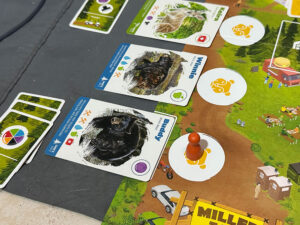 In recent years, animal-loving board game fans have had the good fortune of many new, good games featuring our beloved wildlife. There are the big names, of course, like Ark Nova, but there have been a lot of lesser-known options that are worth a look as well for the animal lover, such as Wild: Serengeti and Zoo King (try them if you haven’t! The latter has the bonus of being light on the pocketbook).
In recent years, animal-loving board game fans have had the good fortune of many new, good games featuring our beloved wildlife. There are the big names, of course, like Ark Nova, but there have been a lot of lesser-known options that are worth a look as well for the animal lover, such as Wild: Serengeti and Zoo King (try them if you haven’t! The latter has the bonus of being light on the pocketbook).
I have always had an affinity for zoos, and am supportive of their educational and conservation values in their modernized forms, so I always like giving zoo-themed (or similar) games a look. Miller Zoo was one that caught my eye in a list of potential games to review. It is a cooperative game for 1-6 players which plays relatively quickly in 30 minutes.
Gameplay Overview:
While Miller Zoo does have the zoo-building element featured in a lot of zoo-themed games, it goes a bit more “under the hood” so to speak, with your primary challenges as a team being dealing with the ongoing needs of the animals. This causes you to do a bit of juggling, as intaking new animals (that’s the zoo-building element) is your primary objective, but is a bit in conflict with the ongoing maintenance of the animals already under your care. How does this work? You just take it one day at a time. Literally!

Each round of this cooperative game is divided into four phases: Dawn, Morning, Afternoon, and Night. The Dawn and Morning consist of preparing for the day and identifying the animals’ needs. At Dawn, every player draws resource cards that they will have access to for the round, while in the Morning, each player draws a needs card. All the animals currently in your zoo (there are some printed on the board so you never have none) have needs icons, and every animal that has an icon matching a drawn needs card gets a token. By the end of the round, your team needs to meet the animals’ needs and remove these tokens by using the resource cards you drew during the Dawn phase.

The Afternoon is when the real work begins. Your resource cards have the same icons on them as the animal needs, and can be used (discarded) to meet the needs of an animal, and discard the appropriate token. The wrinkle is that you must be in the habitat area (farm, tropics, or forest) housing that animal to meet its needs with a resource card, and the resource cards themselves are how you move around to the different habitats in the zoo (again, by discarding them). Complicating this further are the four receiving spaces on the side of the board with potential new animals. The game only ends once you have received all seven new animals, and receiving an animal also takes resource cards, which can only be placed when you’ve moved to its receiving space. As you can see, it becomes a big puzzle to look at your hands and figure out the best course of action.
Most of the action takes place in the Afternoon. The Night phase is mostly end-of-round clean-up. The main action in the Night phase that can occur is a Crisis if you failed to resolve all of the animals’ needs during the afternoon. Essentially you burn cards from the top of the resource deck until resources matching the still in-play needs are revealed and the tokens are discarded. This is important since, in addition to winning by receiving all seven animals, you can lose by running out of resources!

Game Experience:
If most of this seems pretty straightforward, it is. It is largely problem solving, and deciding how best to utilize your available resources, which in many ways is much like a real zoo. That’s really just the beginning though. The game also has a number of envelopes. Most envelopes have new sets of animals to receive, and additional rules to apply. For example, the animals in the starter game require three resources to receive into the zoo, but the final set in the last envelope requires seven resources each! That’s a significantly greater challenge. This increase in difficulty is offset (partially, at least) by the new rules that each envelope also introduces. An example here is the character cards. They start out blank, with the only difference being player color. As you progress through the additional rules, they gain more abilities and the choice of character card becomes relevant to your strategy.

At its core, the game is engaging. One player typically doesn’t have all of the answers and the cards everyone holds are relevant, which is an important aspect of any good cooperative game. The choice to make the maintenance of your current animals and receivership of new animals require the resource felt like a good choice, as it requires a balancing act. If you focus too much on receiving new animals to rush to the end of the game, you compromise your current animals which can backfire during the Night phase when you have a Crisis (or more likely, Crises). If you don’t worry about bringing in the new animals, then you will eventually just run out of cards anyway. And, of course, one other element of this balancing act is that the more animals you bring in, the more potential needs tokens will be out there the next Morning.

The basic version that is in the box before envelope #1 is probably too easy for most people reading this review, but as it bills itself as a cooperative family game, it is probably a good intro level for that audience to ease into the mechanics without much in the way of rules overhead to worry about. The envelopes do upgrade the difficulty such that even more seasoned zoo-game-players are likely to suffer defeats. If and when that should happen, the game also has tool cards, which you get one of for your next game whenever you suffer a defeat. They are pretty powerful effects that you can use once during that game that might help you overcome a challenge that has you stumped.
Speaking of challenges, the envelopes also contain cards with 25 total different challenges to accomplish, such as completing a game by receiving 12 animals or completing a game in 15 minutes. Your progress on each of these can be marked on the back of the board with stickers that are also included in the envelopes that present those challenges. Finally, among the added rules are setup rules for “classic” or “advanced” games for after you have completed all of the challenges provided. It has a bit of an achievements feel to it, and it did strike me as a little odd. It is another element of it that I think is aimed more at that family audience than anything else.
Final Thoughts:

I think it is worth mentioning that Miller Zoo is in fact a real zoo in Quebec (website, though it is in French). The character cards are actual staff members of the zoo. I wasn’t able to ascertain for certain if the zoo was benefitting from sales of the game or if it was just an effort at education and awareness, but it is advertised on their site so I assume it is helping their conservation and rehabilitation efforts, which is a huge plus.
As to the game itself, I did like it, but the heavy use of stickers was a hard sell for me. All of the additional rules are added into the rulebook with stickers. The character cards are modified with stickers. The challenge progress is marked on the back of the board with stickers. It is just a lot, and I have never liked that sort of thing, even in small doses (and this is a big dose!). Ultimately, what the modified rules call the Classic game (using three each of the level 1, level 2, and level 3 animals for your receiving deck) is what feels like the game could have just been without the additional rules build up and stickers.
From what I know of actual zoos, Miller Zoo does a nice job representing that in a board game. The inherent problem solving and juggling of priorities feels right. A game like Ark Nova has always felt more academic and a bit fantastical (not to knock Ark Nova, as it is a good game), while this has a feeling of greater realism, at least for most zoos. The basic starter difficulty out-of-box is too easy for most, as I mentioned, but it is fairly easy to modify that difficulty to your liking. With four different levels of animals ultimately, there’s a lot of fine-tuning you can do to find your desired difficulty.
Final Score: 3.5 Stars – A mostly realistic take on the zoo-game genre that has engaging problem solving, but relies a bit too much on legacy-style stickers to build up the game.
 Hits:
Hits:
• The problem solving is engaging, and keeps you thinking.
• Provides some realism to the genre by balancing upkeep with new animal intake.
• If you like challenges, there is a lot of replay value in trying to get all 25 of them.
Misses:
• The stickers are a bit over the top.
• The difficulty out of the box is likely a bit on the easy side for most.
• It could have just been pared down to the Classic game mode with options to increase the difficulty.






















